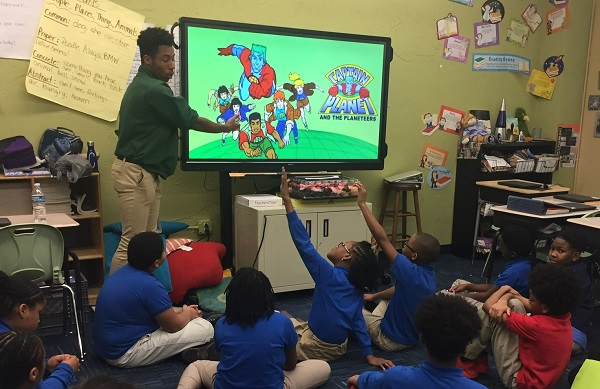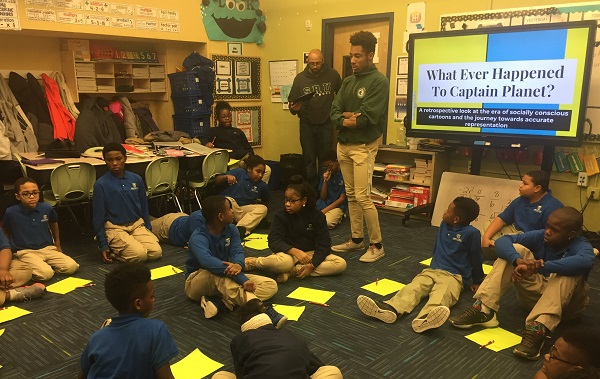
Cartoons can encourage regard for social issues along with laughter
When Brandon McClendon flips on the television to watch cartoons, he sees a diverse group of characters.
But the 23-year-old North Side resident was struck by the fact that the shows often lack conversations about important issues in society as they did when he was a kid. “Captain Planet,” for example, was about a superhero and a group of teens who fought for the environment.
Then, watching the Golden Globes, he heard Oprah Winfrey talk about “speaking your truth” and the importance of sharing your passions. McClendon was motivated to do something.
“I was like, ‘Wow, there needs to be more conversations and workshops about the ways the media affects us,’ ” says McClendon, TeenBloc coordinator at A+ Schools, who has creates workshops for high school students. This subject was right up his alley.
He crafted a workshop for kids called “Whatever Happened to Captain Planet?” for A+ Schools, a community advocate and leader for educational equity and excellence in Pittsburgh Public Schools.

Fifth graders at Urban Academy of Greater Pittsburgh Charter School recently participated in the workshop.
McClendon showed the kids clips from various animated programming – an “X-Men” movie, “Hey Arnold!,” “The Proud Family” and, of course, “Captain Planet.”
He asked the kids the all-important questions: What did you notice? What did you see?
Below the surface, there were larger issues at play. In the “Hey Arnold!” cartoon, for example, a wrecking ball was about to destroy a neighborhood.
McClendon raised the question: Why is this a problem?
It clicked.
“Where’s everybody supposed to go?” one student asked.
“It made them pause and think, ‘What does this mean for people in real life when things like this happen,’ ” says Amie Matson, director of family and youth engagement at A+ Schools, who participated in the workshop.
Cartoons can highlight important issues in real life, from race to gentrification to environmental problems in society, McClendon points out.
Kids should see characters that represent themselves with everything from the color of their skin to their personalities and strengths, Matson says. Kids need to be able to see themselves in the cartoons they watch.
“Representation matters,” she says. “There needs to be diverse representation.”
But the questions need to be asked to get the conversation started.
While the workshop did just that, McClendon says, it doesn’t take his team to start a dialogue with kids. Parents can easily begin the discussion at home. Here’s how:
- First, pay attention to what your child is watching. Why are they watching it?
- During commercial breaks, ask them questions and start the conversation. Are there certain characters they like? Why?
- Ask kids what is appealing about the cartoon. What do they find attracts them?
- Look to see if any of the characters are similar to your kid. If not, find a cartoon show in which they are represented.
“Learning can’t just happen during the school day,” McClendon says. “There are shows out there that are fun, but our minds also are working when we think about what’s really happening in them.”
Schools or community groups interested in hosting the workshop can email Matson at amatson@aplusschools.org or bmcclendon@aplusschools.org. The program is free, but donations are encouraged.